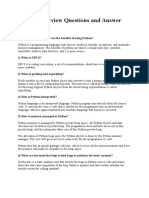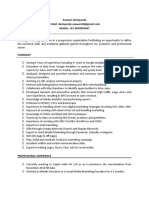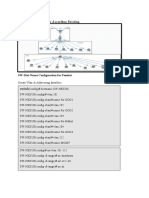0 ratings0% found this document useful (0 votes)
12 viewsPython-Interview-ques
Uploaded by
Sanket AraliCopyright
© © All Rights Reserved
Available Formats
Download as DOCX, PDF, TXT or read online on Scribd
0 ratings0% found this document useful (0 votes)
12 viewsPython-Interview-ques
Uploaded by
Sanket AraliCopyright
© © All Rights Reserved
Available Formats
Download as DOCX, PDF, TXT or read online on Scribd
You are on page 1/ 4
1. What is __init__?
2. What is the difference between Python Arrays and lists?
3. Explain how can you make a Python Script executable on Unix?
4. What is slicing in Python?
5. What is docstring in Python?
6. What are unit tests in Python?
7. What is break, continue and pass in Python?
8. What is the use of self in Python?
9. What are global, protected and private attributes in Python?
10. What are modules and packages in Python?
11. What is pass in Python?
12. What are the common built-in data types in Python?
13. What are lists and tuples? What is the key difference between the two?
14. What is Scope in Python?
15. What is PEP 8 and why is it important?
16. What is an Interpreted language?
17. What is a dynamically typed language?
18. What is Python? What are the benefits of using Python
19. What are Dict and List comprehensions?
20. What are decorators in Python?
21. What is Scope Resolution in Python?
22. What are Python namespaces? Why are they used?
23. How is memory managed in Python?
24. What is lambda in Python? Why is it used?
25. Explain how to delete a file in Python?
26. What are negative indexes and why are they used?
27. What does *args and **kwargs mean?
28. Explain split() and join() functions in Python?
29. What are iterators in Python?
30. How are arguments passed by value or by reference in python?
31. How Python is interpreted?
32. What is the difference between .py and .pyc files?
33. What is the use of help() and dir() functions?
34. What is PYTHONPATH in Python?
35. What are generators in Python?
36. What is pickling and unpickling?
37. . What is the difference between xrange and range in Python?
38. How do you copy an object in Python?
39. How will you check if a class is a child of another class?
40. What is init method in python?
41. Why is finalize used?
42. Differentiate between new and override modifiers.
43. How is an empty class created in python?
44. Is it possible to call parent class without its instance creation?
45. Are access specifiers used in python?
46. How do you access parent members in the child class?
47. What is Python? List some popular applications of Python in the world of technology.
48. What are the benefits of using Python language as a tool in the present scenario?
49. Is Python a compiled language or an interpreted language?
50. What does the ‘#’ symbol do in Python?
51. What is the difference between a Mutable datatype and an Immutable data type?
52. How are arguments passed by value or by reference in Python?
53. What is the difference between a Set and Dictionary?
54. What is List Comprehension? Give an Example.
55. What is a lambda function?
56. What is a pass in Python?
57. What is the difference between / and // in Python?
58. How is Exceptional handling done in Python?
59. What is swapcase function in Python?
60. Difference between for loop and while loop in Python
61. Can we Pass a function as an argument in Python?
62. What are *args and **kwargs?
63. Is Indentation Required in Python?
64. What is Scope in Python?
65. What is docstring in Python?
66. What is a dynamically typed language?
67. What is a break, continue, and pass in Python?
68. What are Built-in data types in Python?
69. How do you floor a number in Python?
70. What is the difference between xrange and range functions?
71. What is Dictionary Comprehension? Give an Example
72. Is Tuple Comprehension? If yes, how, and if not why?
73. Differentiate between List and Tuple?
74. What is the difference between a shallow copy and a deep copy?
75. Which sorting technique is used by sort() and sorted() functions of python?
76. What are Decorators?
77. How do you debug a Python program?
78. What are Iterators in Python?
79. What are Generators in Python?
80. Does Python supports multiple Inheritance?
81. What is Polymorphism in Python?
82. Define encapsulation in Python?
83. How do you do data abstraction in Python?
84. What is a namespace in Python?
85. What is PIP
86. What is a zip function?
87. What is monkey patching in Python?
88. Write a code to display the current time?
89. What are Access Specifiers in Python?
90. Python Global Interpreter Lock (GIL)?
91. What are Function Annotations in Python?
92. What are Exception Groups in Python?
93. What is Python Switch Statement
94. What is Walrus Operator?
95. What is the difference between global and local scope?
96. What is an iterator in Python?
97. When should you use lambda functions in Python?
98. What is the difference between lists, tuples and sets?
99. How can you check if all the characters in a string are alphanumeric?
100. How can you convert a string to an integer?
101. What is indentation in Python, and why is it important?
102. What is the correct syntax to output the type of a variable or object in Python?
103. Which collection does not allow duplicate members?
104. Can you list Python's primary built-in data types, in categories?
105. What are Membership Operators?
106. Which statement can be used to avoid errors if an if statement has no content?
107. What are Arbitrary Arguments?
108. How can you create and use a Module in Python??
109. Can you copy a List in Python by simply writing: list2 = list1?
110. How can you return a range of characters of a string?
111. What is a class in Python, and how do you use it?
112. Why Python?
113. What kinds of applications can Python be used for?
114. What are the advantages of Python?
115. What is PEP 8?
116. What do you mean by Python literals?
117. Describe the Python Functions?
118. What is Python's paramter passing system?
119. In Python, how do you overload methods or constructors?
120. What is the difference between remove() function and del statement?
121. What is swapcase() function in Python?
122. How to remove whitespaces from a string in Python?
123. How to remove leading whitespaces from a string in the Python?
124. Why do we use join() function in Python?
125. Give an example of shuffle() method?
126. Which are the file related libraries/modules in Python?
127. What are the different file processing modes supported by Python?
128. What are the different types of operators in Python?
129. How to create a Unicode string in Python?
130. What are the rules for a local and global variable in Python?
131. What is a generator in Python?
132. What is a negative index in Python and why are they used?
133. Which programming language is a good choice between Java and Python?
134. What is the usage of help() and dir() function in Python?
135. What are the differences between Python 2.x and Python 3.x?
136. How Python does Compile-time and Run-time code checking?
137. What is the shortest method to open a text file and display its content?
138. What is the usage of enumerate () function in Python?
139. What is type conversion in Python?
140. Why do lambda forms in Python not have the statements?
141. What is self in Python?
142. In Python, how can you generate random numbers?
143. What is PYTHONPATH?
144. What are modules in Python? Name a few regularly utilized worked in modules in
Python?
145. What is the difference between range & xrange?
146. What is the difference between a mutable data type and an immutable data type?
147. Explain List, Dictionary, and Tuple comprehension with an example.
148. What is the Python “with” statement designed for?
149. Why use else in try/except construct in Python?
150. What are context managers in Python and how are they implemented?
151. What are the advantages of NumPy over regular Python lists?
152. What is the difference between merge, join and concatenate?
153. How do you identify and deal with missing values?
154. How can you replace string space with a given character in Python?
155. What is Control Flow Statements
156. . What is object-oriented programming (OOP) in Pyt
157. What is the difference between a shallow copy and a deep copy in Python?
158. How do you handle exceptions in Python?
159. What is a tuple in Python?
160. How is Multithreading achieved in Python?
161. How is Multithreading achieved in Python?
162. How will you Merge elements in a Sequence?
163. Differentiate between append() and extend().
164. How do you use Print() without the newline?
165. How do you use the split() function in Python?
166. Is Python object-oriented or functional programming?
167. What is the difference between Matrices and Arrays?
168. What are global, protected and private attributes in Python
169. Is Python case sensitive?
170. What is the Difference between for loop and while loop in Python?
171. How does Python manage memory? Explain the role of reference counting and
garbage collection.
172. Does Python support multiple Inheritance?
173. Which sorting technique is used by sort() and sorted() functions of python?
174. Which is faster, Python list or Numpy Arrays?
175. How are classes created in python?
176. What is the process of compilation and linking in Python?
177. What is an Expression?
178. What is == in python?
179. Do runtime errors exist in Python? Explain with an example.
180. Is Django better than flask?
181. How can you ensure that your Python code is compatible with both Python 2 and
Python 3?
182. Why doesn't Python deallocate all memory upon exit?
183. Why is a set known as unordered? Is it mutable or immutable?
You might also like
- The C# Player's Guide - 5th Edition - 5.0.083% (18)The C# Player's Guide - 5th Edition - 5.0.0497 pages
- Introduction To Computer Theory by Cohen Solutions Manual80% (5)Introduction To Computer Theory by Cohen Solutions Manual198 pages
- Ap Computer Science Principles Practice Exam and Notes 202186% (7)Ap Computer Science Principles Practice Exam and Notes 2021108 pages
- Hacking The Art of Exploitation 2nd Edition Jon Erickson100% (20)Hacking The Art of Exploitation 2nd Edition Jon Erickson492 pages
- PrepTest 83 - Print and Take Test - 7sage Lsat100% (3)PrepTest 83 - Print and Take Test - 7sage Lsat46 pages
- 300 Python Interview Questions and Solutions100% (1)300 Python Interview Questions and Solutions88 pages
- Python Interview Questions: What Are Python Modules? What Are Python Modules?No ratings yetPython Interview Questions: What Are Python Modules? What Are Python Modules?2 pages
- Python Questions for Cloudy Coders DriveNo ratings yetPython Questions for Cloudy Coders Drive28 pages
- python programming question bank unit wise by Rupesh ✓No ratings yetpython programming question bank unit wise by Rupesh ✓24 pages
- Coding With JavaScript For Dummies Everything To Know About JavaScript (2020) - 40153100% (1)Coding With JavaScript For Dummies Everything To Know About JavaScript (2020) - 40153247 pages
- NWO, Illuminati, Freemason, Occult, Bible Prophecy, Conspiracy, Secret Society, Etc. LinksNo ratings yetNWO, Illuminati, Freemason, Occult, Bible Prophecy, Conspiracy, Secret Society, Etc. Links47 pages
- Structured and Unstructured Maintenance With Example0% (1)Structured and Unstructured Maintenance With Example9 pages
- Python Programming For Beginners - A Crash Course To Learn Python and Other Recommended Coding83% (6)Python Programming For Beginners - A Crash Course To Learn Python and Other Recommended Coding86 pages
- LINUX COMMAND LINE An Introduction To Linux Command Line EnvironmentNo ratings yetLINUX COMMAND LINE An Introduction To Linux Command Line Environment174 pages
- Learn To Code HTML and CSS Develop Style Websites PDF100% (2)Learn To Code HTML and CSS Develop Style Websites PDF595 pages
- How To Use PATS Module Initialization FunctionNo ratings yetHow To Use PATS Module Initialization Function5 pages
- Global Branded Content Ads Setup Guide - Family of AppsNo ratings yetGlobal Branded Content Ads Setup Guide - Family of Apps26 pages
- 12th-Computer-Science-EM-Half-Yearly-Exam-2023-Question-Paper-Virudhunagar-District-English-Medium-PDF-DownloadNo ratings yet12th-Computer-Science-EM-Half-Yearly-Exam-2023-Question-Paper-Virudhunagar-District-English-Medium-PDF-Download2 pages
- Management Information Systems Question BankNo ratings yetManagement Information Systems Question Bank41 pages
- Quantum-Inspired Classical Algorithms For Recommendation SystemsNo ratings yetQuantum-Inspired Classical Algorithms For Recommendation Systems68 pages
- M72!01!04 ChipKey Encoder Owners ManualNo ratings yetM72!01!04 ChipKey Encoder Owners Manual37 pages
- ISEM Audio Ego-Phase 2 CD Drive With Philips CD-pro II - EbayNo ratings yetISEM Audio Ego-Phase 2 CD Drive With Philips CD-pro II - Ebay3 pages
- Hpe 3par Os 3.3.2: Julie Chang Product ManagerNo ratings yetHpe 3par Os 3.3.2: Julie Chang Product Manager11 pages
- Asawari Deshpande Digital Marketing 23 10No ratings yetAsawari Deshpande Digital Marketing 23 105 pages
- 2QI - S4CLD2302 - BPD - EN - US Demand-Driven Replenishment Planning and ExecutionNo ratings yet2QI - S4CLD2302 - BPD - EN - US Demand-Driven Replenishment Planning and Execution42 pages
- ST Openstack Storage For Dummies 9781119292531 201606 enNo ratings yetST Openstack Storage For Dummies 9781119292531 201606 en29 pages
- Kominfo Configuration According ExistingNo ratings yetKominfo Configuration According Existing13 pages
- ESCAPE-31, June 6-9, 2021 Istanbul Turkey PDFNo ratings yetESCAPE-31, June 6-9, 2021 Istanbul Turkey PDF1 page























































































































